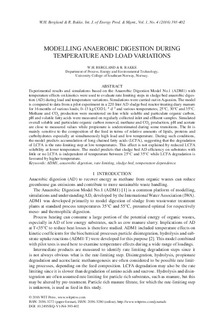| dc.contributor.author | Bergland, Wenche Hennie | |
| dc.contributor.author | Bakke, Rune | |
| dc.date.accessioned | 2017-02-22T12:17:54Z | |
| dc.date.accessioned | 2017-04-19T12:52:14Z | |
| dc.date.available | 2017-02-22T12:17:54Z | |
| dc.date.available | 2017-04-19T12:52:14Z | |
| dc.date.issued | 2016 | |
| dc.identifier.citation | Bergland, W.H., Bakke, R. (2016). Modelling anaerobic digestion during temperature and load variations. International Journal of Energy Production and Management, 1, 393-402. | |
| dc.identifier.issn | 2056-3272 | |
| dc.identifier.uri | http://hdl.handle.net/11250/2438499 | |
| dc.description.abstract | Experimental results and simulations based on the Anaerobic Digestion Model No.1 (ADM1) with temperature effects on kinetics were used to evaluate rate limiting steps in sludge bed anaerobic digestion (AD) during load and temperature variations. Simulations were carried out in Aquasim. The model is compared to data from a pilot experiment in a 220 liter AD sludge bed reactor treating diary manure for 16 months of various loads; 0–13 kg COD L−1 d−1 and various temperatures; 25°C, 30°C and 35°C. Methane and CO2 production were monitored on-line while soluble and particulate organic carbon, pH and volatile fatty acids were measured on regularly collected inlet and effluent samples. Simulated overall soluble and particulate organic carbon removal, methane and CO2 production, pH and acetate are close to measured values while propionate is underestimated during some transitions. The fit is mainly sensitive to the composition of the feed in terms of relative amounts of lipids, proteins and carbohydrates especially at simultaneously high load and low temperature. During such conditions, the model predicts accumulation of long chained fatty acids (LCFA), suggesting that the degradation of LCFA is the rate-limiting step at low temperatures. This effect is not explained by reduced LCFA solubility at lower temperature. The model predicts that sludge bed AD efficiency on substrates with little or no LCFA is independent of temperature between 25°C and 35°C while LCFA degradation is favoured by higher temperature. | |
| dc.language.iso | eng | |
| dc.publisher | Wit Press | |
| dc.subject | ADM1 | |
| dc.subject | anaerobic digestion | |
| dc.subject | sludge bed | |
| dc.subject | rate limiting | |
| dc.subject | temperature dependence | |
| dc.title | Modelling anaerobic digestion during temperature and load variations | |
| dc.type | Journal article | |
| dc.type | Peer reviewed | |
| dc.description.version | Published version | |
| dc.identifier.doi | 10.2495/EQ-V1-N4-393-402 | |
